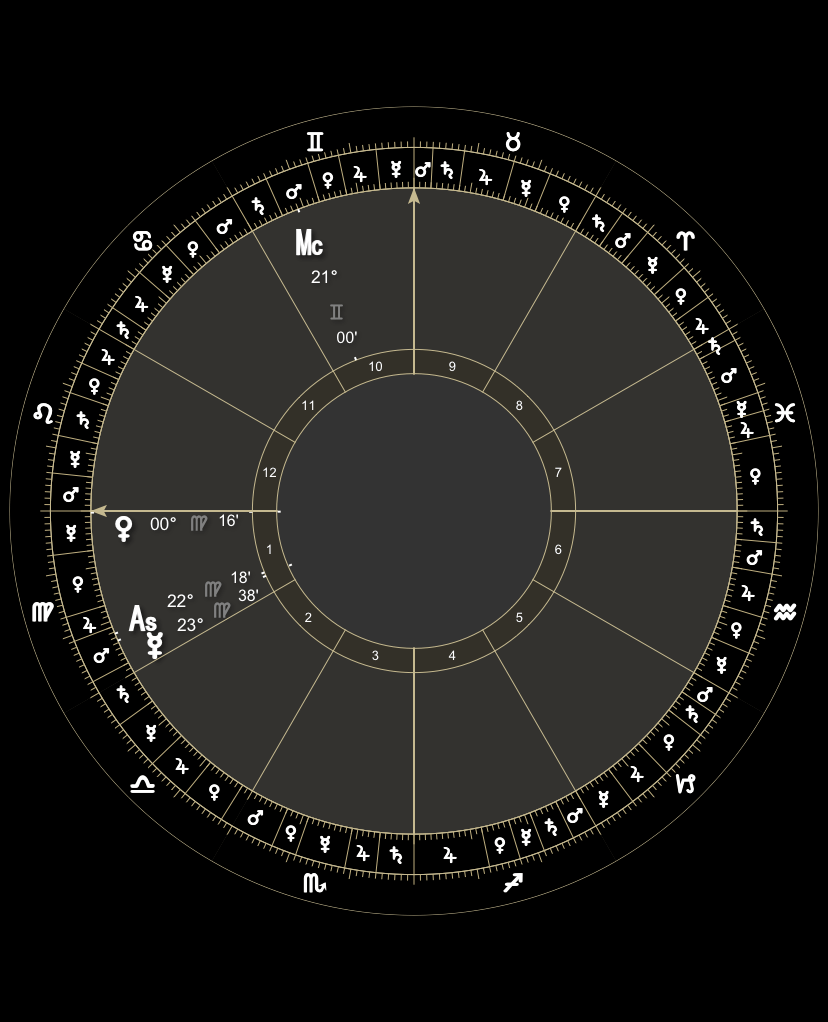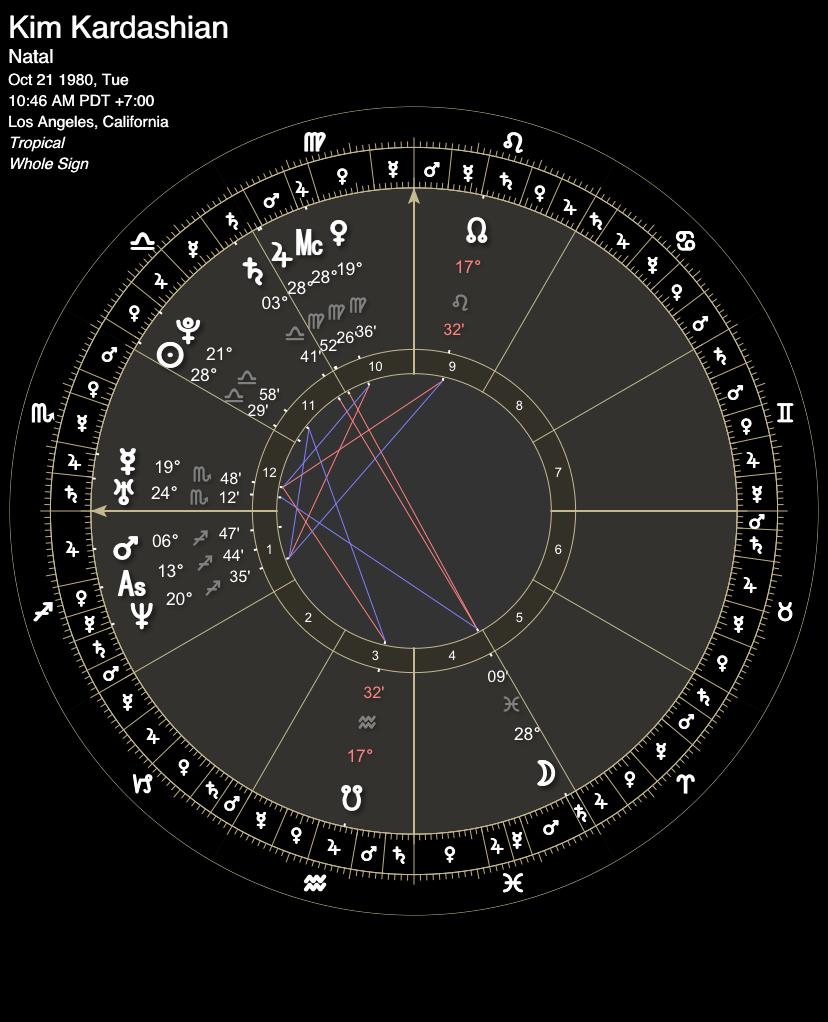The moment we are born and take our first breath, the degree which is marked on the horizon is said to symbolize this point when our soul enters our body. This is the way of thinking across many astrological traditions. This is the Ascendant, or, the first house in astrology.
Astronomically, this degree is where the horizon meets the sky. Then, the Zodiac sign in which this degree falls is the Rising Sign. In Placidus, the exact degree of the Ascendant marks the starting point of the first house. In Whole Sign Houses, the Rising Sign is the first house through the entire thirty degrees.
As I am an astrologer with a Hellenistic foundation, I will be speaking in terms of Whole Sign Houses for the rest of this article. Additionally, this article can be applied to many practices in astrology but will be primarily written for natal astrological considerations. “Natal” meaning birth, and thus “native” refers to the owner of a chart.
The First House as “The Helm”
“Let us begin with The Ascendant, life, steering-oar, body, breath,” is how Vettius Valens introduces the house names in the fourth book of The Anthology translated by Mark T. Riley (p.165). In this translation, the first house in astrology is referred to as “steering-oar,” or the Helm. This is its name according to the ancient tradition. When considering the name of the first house, we can begin to understand its meanings.
The helm of a ship is where you steer and guide the vessel. It’s the point at which all control is held. This is the first house. The first house is you. In the second volume of her texts on ancient astrology, Demetra George notes that, “planets in the first house have their hands on the steering wheel of our ship of life”(p.645-646). These placements have a direct influence on the person to whom the chart belongs.
The Joy of Mercury
In ancient astrology, there are some houses that the planets do better in than others. This is regardless of the Zodiacal sign that they fall in. This concept is called the Planetary Joys.
Let’s look at a (very) brief history of the Joys.
Chris Brennan, in his book Hellenistic Astrology, The Study of Fate and Fortune, references a summary of a text attributed to Hermes and preserved in Thrasyllus’s Tablet (p.341). In this section, he describes that there is reason to believe that this Hermes source is the origin of the Planetary Joys. This means that the concept dates back to “the first century BCE or earlier” (p.342).
According to the Planetary Joys, Mercury rejoices in the first house. And from there we can elaborate on more of its meanings. Mercury rules communication, transition, speech, words, the breath, our thoughts and how we speak them, the senses, and much more. And from Mercury we can come to understand that the first house in astrology represents us. It represents how we speak, how we think, and how we interact with the world— both in body and mind.
“It is the place where the sky and earth unite, and thus Mercury brings together what are seen as contrasting or opposing realms” (Brennan, p.353).

Significations of the First House in Astrology
If we take the name of the first house, the philosophy behind it, and the Joy of Mercury, its meaning starts to come into view. The first house in astrology is where our soul meets our physical form. This place is where we have control. As the two sides of us, our body and soul come together, our breath, our words, and our senses are where they meet. This is the first house.
“The first house denotes life, body, speech, the beginning of all actions, as well as the thoughts on one’s mind” (George, p. 644).
If you want to understand an individual, you start in the first house. Here is where you find how a person presents themselves to the world. “The life force, physical constitution, vitality, and general state of health are all indicated by the first house (George, p.644). Modern astrological practices often relate the entire chart to describe a single individual. However, in ancient or traditional practices, the first house is the only true place where the native is represented. Regardless of what practice you follow, the first house in astrology is going to be about the native.
Technical Points of the First House
Each of the twelve houses in astrology hold different qualities. These qualities lend towards understanding them. I will be posting a blog post to elaborate more on these technical qualities (sign up for my newsletter for updates!), so for now I’ll keep it brief.
Two important qualities to consider are angularity and visibility to the Ascendant. Of course, the first house is already the Ascendant, so in terms of how houses “see” each other, this is a good thing. Visibility to the ascendant immediately sets that house up to be preferable. Because we, the native of our chart, are best able to understand and utilize that which we can witness in our lives. In contrast, aversion would be our blind spots— but the first house in astrology doesn’t have to worry about that.
The next big piece is angularity. The ancients called these places “pivots” and they represented the greatest points of activity. The angles are “associated with the present” (Brennan, p.331). Chris Brennan describes that, according to the ancients and Nechepso in particular, the four angles in a chart are seen as “advantageous” to the native (p.334). The first house is one of these angles.
The combination of the first house being the Ascendant and thus witnessing itself inherently, as well as angularity makes it the best house for a planet to fall in. Planets here will be readily apparent in a person’s life and will often manifest themselves through the native’s body and character.
Ruler of the First House — The Lord of the Hour Marker
You cannot understand the first house in its entirety without considering the ruling planet of that sign. This is where the uniqueness of each chart starts to become apparent. There are twelve possible Rising signs, and further, twelve possible signs in which its ruler can fall. A Leo Rising with the Sun in Aquarius is going to be a very different individual from a Leo Rising with the Sun in Aries. The expression of this ruling planet in its condition within the chart will lend vast amounts of information to understanding the first house in astrology.
“The domicile lord of the Ascendant is the planet most closely connected to the life force, which includes a person’s vitality, body, health, constitution, longevity, and character” (George p.975).
The condition of this planet and how it lends to these points can be derived by its house placement, the sign, and planetary aspects to it. Then, you must consider the house in which this planet falls. This will lend towards a sense of direction that the native moves towards through their life. If the ruler of the first house isn’t the Sun or Moon, it will (traditionally) have two signs that it rules. The meanings of the house in astrology this second sign falls will also pull in meaning and relevance to the first house.
For an in-depth breakdown of how to understand the ruler of the first house in terms of life direction, I recommend Demetra George’s book, Astrology and the Authentic Self, Traditional Astrology for the Modern Mind. I’ll link it below.
Planets in the First House
As mentioned above, planets in the first house have a lot to say about a person. They can influence appearance, personality, health, and how they interact with the world. These meanings can often be incredibly literal.
Saturn in the first house in good condition may represent someone who is disciplined and traditional in nature. Whereas someone with Saturn in poor condition in the first may be prone to health conditions by blockages or perhaps rigid in personality. Someone with Jupiter in the first house may be optimistic and generous or driven by concepts of morality. These are just some examples.
Then you have to consider the other signs which that planet rules. Those signs will occupy different houses in astrology. Then, that ruling planet will import the meanings of the houses it rules into the house in which it is placed.
So, let’s break it down. If you have Aries Rising with Venus in the first house, consider the houses that Venus rules. These would be the seventh house Libra and the second house Taurus. The meanings of the seventh and the second house in astrology will be directly relevant to the native’s character, mind, speech, life direction, and vitality. In short, relationships and money will likely be important to them. This may go as far as to say relationship and financial stress directly impacts the health of the native.
This example is incredibly simplified. As this series on the houses in astrology continues, the complexity of each house will become apparent and the nuances of this concept will be easier elaborated.
Case Study: Anonymous

This is the chart of a dear friend of mine. Virgo rising, Venus and Mercury in the first house, and Mercury conjunct the Ascendant degree as its ruler. I chose this chart as an example of the first house because she has a rejoicing Mercury according to the Planetary Joys.
This certainly shows up in her life as she is a person who has always managed to be extremely technologically skilled. She can build just about anything. Her self-built computer is her pride and joy. Custom keyboards are something she does for fun and, if asked, she would build one for any of her friends because she enjoys it. She builds websites, programs, code, structures with wood, small scale models, and legos. I’ve even seen her build her own retro hand-held gaming console. As Mercury also rules her tenth house in astrology which signifies public reputation, she is well known for all of these niche technical skills.
But she doesn’t just have Mercury in the first house, she also has Venus which rules her second and ninth houses in astrology. We’ll elaborate on these houses later in this series, so for now I’ll keep it short. The relevant meanings for this example are as follows: the second house represents income and possessions while the ninth house in astrology represents long distance travels.
This friend of mine has had a stable, consistent job in tech for years now which helped to provide the physical possessions she needs for all of these hobbies and skills she has. It also allowed her the financial stability she needed to travel across the country at a young age on her own. This move was major, and difficult. But it ultimately allowed her to explore her queer identity early on.

Guest Astrologer Space: Aniah of Illuminiah
For this study of the first house in astrology, I reached out to the talented young astrologer, and first house Sagittarius Jupiter native, Aniah for her thoughts and insight. What she had to say wraps up the first house in astrology incredibly well.
Aniah’s thoughts on the first house in astrology
There are areas of life in a natal chart which signify things that fall outside of our own control as individuals, and some that are connected to us but aren’t necessarily about us. However, the first astrological house (traditionally named the Helm) is one where we have the most control; it’s the house which signifies the individual. It is a representation of our literal, physical emergence into this world – the moment we took our first breath independent of the umbilical cord. It is embodiment, expression, identity, character, and behavior. We have direct control over how we express ourselves.
Because of the Helm’s prominence in a natal chart, it’s understandable why the significations of any planet that falls within the first house becomes very pronounced or “loud”. Planets in the first house are brought to the literal forefront of an individual’s life, not to be tucked away or hidden in the weaker or averse houses.
Aniah’s case study: Kim Kardashian

An interesting first house placement example is the natal chart of Kim Kardashian. Kim has Mars in her first house. She is a Sagittarius rising, with her chart ruler (Jupiter) in her tenth house of career and public image. Her Sagittarius Mars is not only being fed resources by her Virgo Jupiter in the tenth house, but it also falls within Jupiter’s bounds in her first house. This means that her motivations, drive, and ambitions— which come to serve her tenth house —are all displayed quite evidently through her behavior, identity, and character.
Due to her first house Mars being on Jupiter’s terms, her pursuit in achieving tenth house abundance sometimes comes off as very tireless, forceful, daring, and extreme— which are all Martial significations. She has both benefics (Venus and Jupiter) in her tenth house, so this is an area of life that’s clearly of the utmost importance to her, and, because of that tireless first house Mars, she has full access to all the resources she needs in order to continue to go to any extremes necessary for her tenth house.
Making headlines
The most recent example of Kim’s forcefulness is her infamous MET Gala appearance in Marilyn Monroe’s dress. Kim trained vigorously for three weeks, adopted a highly restrictive diet, and intensely negotiated with the heads of Ripley’s Museum in order to acquire and fit into a dress that she’d only wear for a matter of minutes on the red carpet. She confessed to losing sixteen pounds in only three weeks just to simply take pictures in a dress. Most people thought she was ridiculous for doing something so vain in addition to promoting crash-dieting and damaging Marilyn Monroe’s original dress. However, in Kim’s eyes, there is never any amount of her own blood, sweat, or tears that wouldn’t be worth giving in service to her fame and legacy.
You can find more of Aniah’s work on her socials @illuminiah or you can book a consultation with her here.
Sources
Valens, Vettius, The Anthology, translated by Mark T. Riley
George, Demetra, Ancient Astrology in Theory and Practice, A Manual of Astrological Techniques, Vol 2: Delineating Planetary Meaning
Brennan, Chris, Hellenistic Astrology, A Study of Fate and Fortune
Mentioned
George, Demetra, Astrology and the Authentic Self, Traditional Astrology for the Modern Mind